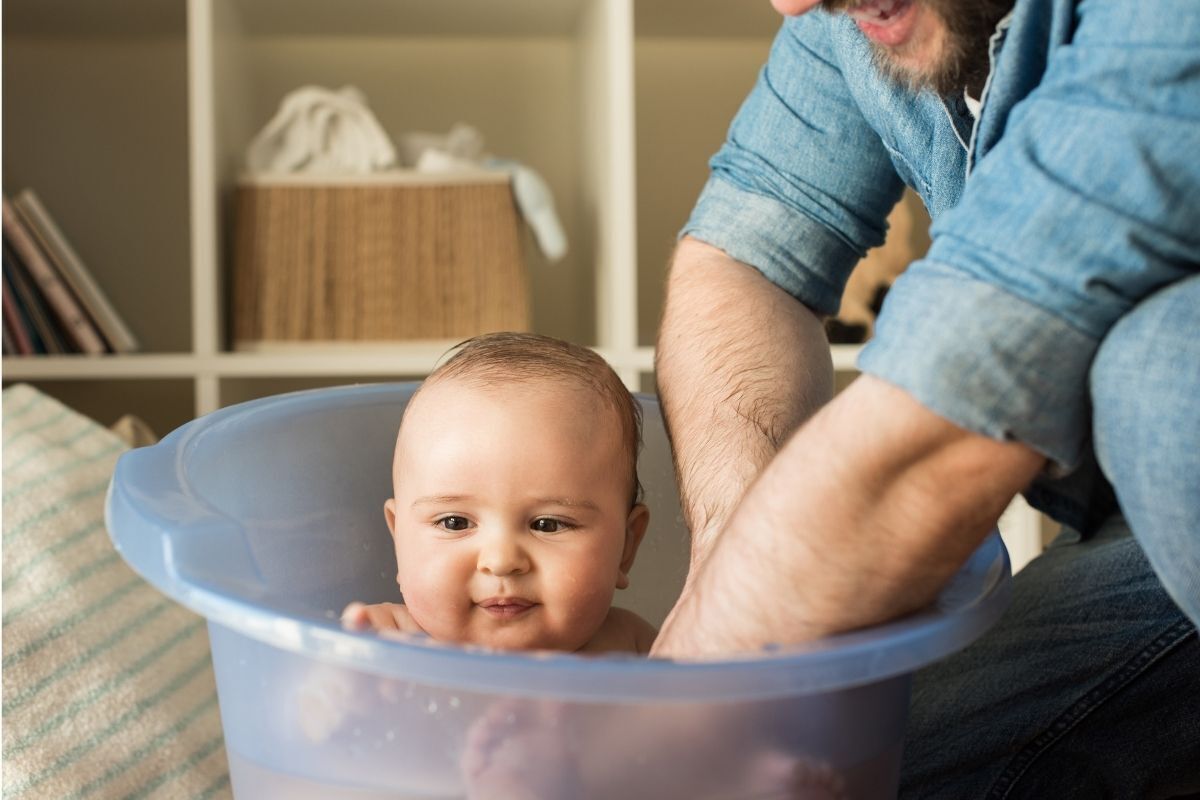Table of contents
Learn all about the Shantala massage technique!

Shantala is a massage performed on babies based on the repetition of movements with only the necessary amount of oil for the hands to glide. The areas of the body where the technique is applied are several, such as face, arms, legs, trunk and feet. The main pillar of Shantala is the connection that is established between parents and babies throughout the process.
Using Shantala on a daily basis makes it a part of the baby care routine. The more constant the massage is, the more benefits can be felt by the little ones. As of the first month of life, the modality also provides interaction between parents and babies beyond touch, since it can stimulate eye contact and voice recognition.
Throughout the article, learn more about Shantala, its impacts on the baby's health and tips to put the massage in practice!
Understanding more about Shantala

Videos of babies being massaged are common on the internet. Shantala is a technique that, like other massage protocols, follows movements with purpose and brings benefits that stand out with its insertion into the routine. For parents and babies, it is an interactive experience with strong emotional appeal. Below, learn how the massage came about and how it works!
What is it?
Shantala is a massage technique that was designed especially for babies. It is performed with a little oil and movements all over the little ones' bodies, in short sessions that can be repeated daily. Besides the massage itself, Shantala is synonymous with connection between the parties involved, since it brings them closer and provides physical and emotional union between parents and babies.
Source
The Shantala technique is ancient and was first seen in Calcutta, India. In the Asian country, baby massage is a tradition widely spread in the culture of families, being customarily performed by mothers. Later, Shantala was taken to other places in the world, becoming popular in the West.
The person responsible for spreading the techniques was the Frenchman Frédérick Leboyer, in the 20th century. A doctor and obstetrician, Leboyer became deeply involved in philosophies related to childbirth, besides writing books on the subject. The doctor spread Shantala in western countries and named the massage in honor of an Indian mother, who had the opportunity to witness her performing the movements.
History of Shantala in Brazil
In the 1970s, the French doctor Frédérick Leboyer took the experience of Shantala discovered in India to the West. In Brazil, the millennial technique arrived in 1978 and, as of that year, it began to spread. As time went by, Shantala became more popular and, today, it is seen as a therapeutic tool that brings more quality of life to parents and babies.
What is it for and how does it work?
The practice of Shantala aims to offer the baby a moment of physical and emotional relaxation. The technique also brings several benefits to the little ones' bodies, which stimulates a better physical and cognitive development in babies. It works with touches, usually from mothers or fathers, directly on the children's skin, bringing them closer and creating a very beneficial interaction.
Shantala works by stimulating all of the baby's senses during the session. The sensory experience is added to the intellectual and motor benefits, as well as the immunological and neural responses and communication skills. It is often said that Shantala is a form of love shared through touch, in which affection and tranquility are transmitted to babies.
Scientific evidence
The therapeutic effectiveness of Shantala refers to the impacts that massage brings to babies and children, with scientific proof. Studies on the technique show that the benefits arise with regular practice, and some can be felt after each of the sessions. Even for the little ones who have pain and limitations, Shantala is a tool with guaranteed benefits.
When to start doing the baby massage?
Shantala is recommended for babies and children up to seven years old, or as long as the practice is well accepted. Its beginning is recommended from the first month of life, since, at this stage, the little ones are more receptive and ready to establish a deep bond with the person who does the massage. In addition, the possibility of visual and vocal connection with the parents' stimulus is greater, bringing more benefits.
Benefits of Shantala

Shantala has numerous benefits for the entire organism of the little ones. When the babies receive the massage, especially regularly, the contact with the skin of the person who performs the technique provides deep relaxation. Besides the positive aspects for the body, such as gas relief and weight gain, the emotional also benefits. Below, check out the advantages of the technique!
Relief from abdominal cramps
Colic is a nuisance for babies, causing pain, discomfort and irritation. Shantala movements are ideal for relieving pain in general, as they relax the body and improve digestive function. The comfort brought by the loving touch also acts as a natural relaxant, drawing the baby's attention away from the pain and relieving abdominal gas.
Improved immune system
The movements applied through Shantala promote improvement in the immune system of the little ones. The quiet touches and the experience as a whole allow the body to become more resistant to various types of diseases, making it stronger and healthier. Therefore, adding massage to the routine of babies prevents the emergence of health problems.
Increases the connection between mother and child
The touch of the mother's hand on the little ones' skin is the starting point for the creation of a deeply affective bond. Thus, Shantala promotes even more connection when there is eye contact and the use of affectionate verbal commands, which promote closeness and harmony between the parties. Emotional relaxation also works better when the mother herself is calm during the session.
Maturation of the central nervous system
The stimuli offered during Shantala practices are of great contribution to intellectual and cognitive abilities. The recognition of experience, sensations, and hormone production itself assist the functioning of the endocrine system and central nervous system functions. Thus, the development of neurological aspects occurs more efficiently.
Development of the sensory and emotional system
The practice of Shantala induces positive responses in the emotional aspect of the little ones. The exchange provided during the sessions expands the affective bond and stimulates the babies' emotions. The motor system is also greatly stimulated, since the sensitivity of touch and of the nervous system are required.
Visual and auditory aspects are also part of the experience, which can be complemented with soothing music and even aromatherapy. The awareness of one's own body regarding the sensations aroused is another benefit brought by Shantala.
Stimulation of the motor coordination system
Body perception is one of the benefits of Shantala, which comes from the tactile stimulation provided by the massage. Likewise, babies' sensory responses improve, and motor coordination improves with routine Shantala. By working on muscle tone, the Indian technique benefits the motor skills of the little ones, as well as the movements they perform.
Improved breastfeeding and digestion
It is common for babies to have gastrointestinal problems in the first months of life. Digestive difficulties are usually accompanied by irritation and tension, which causes worsening symptoms. Shantala, by promoting muscle relaxation and tranquility of the baby, helps to relieve abdominal discomfort and digestive issues.
Thus, breastfeeding also improves, which helps facilitate digestion of the little ones. Thus, the benefits can be felt from feeding to the stomach and intestines, with minimization of stomach discomfort. Gas is another discomfort that can be combated with the regular practice of Shantala in the baby's routine.
Besides leaving the baby calmer
Shantala is a technique that, with touch, brings tranquility to the little ones. For this to happen, it is important to create a calm atmosphere and respect each baby's adaptation time. It is necessary to advance as feedback proves positive and the baby is receptive to stimuli that transmit love and affection on the part of the parents.
In the beginning, it is possible that the baby will not accept the full massage or will not be effectively relaxed. During the adaptation phase, it is common for the little ones to oscillate and not be ready for the full session. Patience and affection are the keys for Shantala to be successful and promote well-being.
Step by step to do the Shantala on your baby

How about making Shantala a transformative moment in your baby's routine? Just like massage techniques performed in adults, the Indian modality for the little ones can be a ritual, which begins with the oil in the hands of the person who does the massage. From that moment on, each touch provides an exchange between the parties, in a highly emotional connection. Check out the step by step below!
Start with the chest and shoulder area
The chest and shoulders have to do with deeper, more conscious breathing. The first action on the chest is the chest opening, which begins with the hands joined at the center of the baby's body and then moving away towards the arms. The hands follow parallel in a continuous movement towards the little ones' hands.
Thus, the X-shaped movement is performed with one hand on each shoulder and then the drawing of the letter takes place on the baby's chest. This sequence initiates the relaxation process and introduces the Shantala proposal to babies.
Move on to wrists and then hands
On the arms, the most indicated Shantala movements are milking, threading and rolling. They must be performed up to the wrists, where the technique differs to massage the hands. On the wrists, the C movement in the joint is another important detail in the step-by-step of the technique.
The hands have great relevance in Shantala and help to establish connection between the one who massages and the one who receives the massage. Use kneading movements, on the palms, the back of the hands and also on the fingers. Always repeat each one of the actions performed.
Return to the chest region and bring the hands to the bladder
To create a sequential dynamic, the next step of Shantala is to return the hands to the baby's chest and then begin the descent. On the abdomen, perform repetitions of circular movements, hands simulating windmill blades, and vertical movement with one hand and an inverted U with the other. Rotating the hands on the abdomen on the baby until they are parallel is another step.
Next comes the abdominal wrapping with hands, transferring warmth and affection to a significant area in the little ones. The gymnastics in the region consists of abdominal flexions with the legs bent, crossed and also crossing the feet. Crossing the arms over the abdomen and repeating the movement finishes the stage of abdominal gymnastics.
Time to go for the legs
For the legs, the most suitable movements are milking and threading, which should be performed with both hands from the top of the thigh to the ankles. At these joints, make a C with your hands and repeat a few times, on both sides. Then switch to milking from the bottom up and finish with rolling, always keeping the hands parallel, one on each side of the baby's legs.
Don't forget baby's feet
On the feet, Shantala can be applied as on the hands, that is, with the traditional kneading movements on the back and soles of the feet. Repeat a few times and do the same on each one of the toes. In addition, a complement to Indian foot massage is foot reflexology, which brings benefits to the whole body with touches on specific points on the sole of the foot, as in the beginning of acupuncture.
Now position baby facing away from you
The baby's back is a fundamental part of Shantala, since it relaxes all the muscles and brings more comfort to the little ones. After turning him/her over, spread some oil on the back and start circular movements, followed by stretching and kneading the entire length of the area.
Then wrap both hands around the baby's back, exchanging warmth and energy. Repeat each movement a few times.
Turn baby over and massage your face
On the face, start Shantala by the baby's eyebrows. Around them, make X movements on the forehead, use the fingers in a soft tweezer and alternate for a glide to the ears. Pass the fingers along the three lines of the face: from the corner of the nose to the ear; from the corner of the lips to the ear and from the chin to the ear. Reaching them, knead and repeat carefully on the head.
Finally, you can also do Padmasana
Padmasana is the lotus posture, part of Yoga practices, and shows the duality between the part of the being that reaches for the sky and the one that remains with its roots firmly on the ground. In Shantala, it can be adapted to the baby's body as a symbolic closure to the ritual, which goes beyond physical touch: massage is an act of love.
The most important thing is to end the Shantala session with the peace of mind of having done the best possible thing. As the baby adapts to the movements, you can add other techniques and vary the repetitions, always paying attention to signs of satisfaction or possible discomfort. Positive and encouraging affirmations can accompany every step of the massage.
Further information about Shantala

There are quite common doubts when it comes to Shantala. After all, massage techniques involve taking courses, adapting the movements to the needs of those who receive the touches and possible contraindications. Next, learn other important information about Shantala that make all the difference in the therapeutic contact between the hands and the baby's skin!
Tips to make a good massage
Shantala sessions can be differentiated when they become unique moments. So, the first tip is to do the movements with total focus on the baby, without talking to other people, watching television or messing with the cell phone. This detail is fundamental for there to be a deep connection between the parents and the little ones, which influences the results obtained.
Another tip is not to use too much oil, since the amount enough for the hands to slide on the skin is adequate. It is also valid to establish a time for the practice, and some people prefer to do Shantala before or after the bath. Together, the processes help relaxation and bring even more benefits to the baby. Putting the ritual into practice daily helps create a beneficial and soothing massage.
Cautions and contraindications
The Shantala technique involves certain precautions, which directly impact the results of the massage and the baby's feedback. Although creating a routine is important, if there are warning signs the ideal is to leave the session for another time. Physical responses such as shaking, sneezing, and arm or body movements that indicate discomfort are signs.
If the baby does not calm down, becomes more irritated or starts to cry, it is recommended to suspend the session. Physiological needs and physical problems such as fractures, bruises, hernias and atypical skin aspects are other contraindications of Shantala. Cases of respiratory and heart diseases, fever and the presence of the umbilical cord also indicate the suspension of the massage.
Frequency and implementation
Shantala can be applied to babies daily, in sessions that last around ten minutes. The technique can be perfected by parents who, little by little, find the best way to offer this moment to the baby. An interesting detail is to remember that the positive aspects extend to those who offer the massage to the little ones.
For parents, particularly first-time parents, the close contact with their baby helps to ease possible emotional burdens. In addition, Shantala develops a valuable sense of helping the well-being of children from the very touch, which builds more empowerment and confidence for parents during performance.
How to put Shantala into practice? First of all, a clean and calm space is indicated, as well as sanitized towels and an emollient cream or oil. Comfortable clothes for the little ones to wear after the practice are also indicated, or pajamas, if the massage is performed before bedtime. Relaxing sounds can be a good complement to create a calm atmosphere.
How to take a Shantala course?
To take the Shantala course, it is necessary to enroll in centers or schools that offer classes. The course can be totally practical or partially theoretical, with the support of materials such as handouts, for example. The Shantala course is usually taught by doulas or therapists and involves demonstrations and practice of different movements and complements for the application of the technique.
Can it be applied to animals as well?
The Indian massage modality can be applied to animals. However, the way to perform the Shantala techniques changes in relation to the one performed on babies, which requires knowledge and ability to adapt. The benefits felt by the animals also stand out, and they usually enjoy the moment of relaxation and soothing with their owners' touch.
Shantala is a great option for your baby!

Originally from India, Shantala did not take long to gain adepts in several areas of the world. The massage creates unique bonds when performed by the parents themselves, since it uses affection and the energy of touch. For the baby, it is a special moment in everyday life, which brings relaxation and several health benefits, ranging from improved sleep to the reduction of colic and gas.
In a few minutes, especially when part of the daily care routine, Shantala influences the responses of the baby's organism. Hormone levels improve, as does the quality of interaction with the person performing the massage. Perfecting the movements is part of the process, and parents need not feel insecure in their first attempts.
Thus, the intention and closeness established by the touch are always recognized by the little ones. Therefore, even without much practice, the one who massages creates a special and beneficial moment for the baby. The attention received is the greatest differential.

